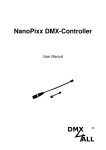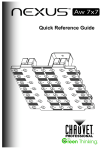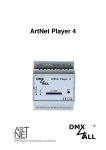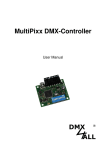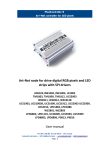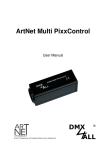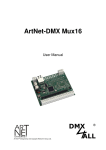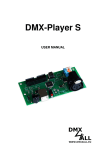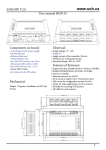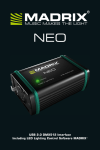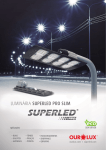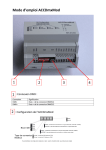Download NanoSD Player
Transcript
NanoSD Player User Manual NanoSD Player 2 Description The NanoSD Player is a Stand-Alone DMX- or LED Pixel-Player. A digital LED-Stripe can be connected directly at the output with up to 340 LED-Pixel. Currently the following Pixel Led will be supported: MagiarLED III flex, MagiarLED II flex, DycoLED, TM1804, TM1812, WS2801, WS2811, LPD8806, UCS1903, APA101 (SuperLED), LPD1886 8Bit, LPD1886 12Bit Alternatively a DMX-output for controlling DMX-capable devices is possible, too. Via an integrated IR-sensor the NanoSD-Player can be remote controlled. The programming occurs only via a Micro-SD-card. So, all settings are available in accordance to the specific project. The user-friendly configuration via the DMX-Configurator allows fast and uncomplicated settings of all parameters and the creation of the replaying programs. Data sheet Power supply: 5-12V (from LED-Stripe or external power supply) ~ 300mA @ 5V / ~ 120mA @ 12V Output: Controlling signal for digital LED-Stripe (max. 340 Pixel) or DMX-signal with 512 channels Digital LED-Stripes: MagiarLED III flex, MagiarLED II flex, DycoLED, TM1804, TM1812, WS2801, WS2811, LPD8806, UCS1903, APA101 (SuperLED), LPD1886 8Bit, LPD1886 12Bit Input: IR-sensor Connection: 5 pin screw terminal (removable) Program memory: Micro-SD-Card (4GB included) Operation: Button and LED-Display at the device Function: RGB-Filter / Firmware-Update-Function Dimensions: 82 x 32 x 27 mm NanoSD Player Connection V+ GND GND CLK DATA POWER 5-12V DC POWER GND LED GND or DMX GND LED CLK or DMX LED DATA or DMX + Output assignment for several LED-Stripe types: LED-Stripe type MagiarLED III MagiarLED II TM1804 TM1812 WS2801 WS2811 LPD8803 Dyco LED UCS1903 APA-101 LPD1886 CLK CLK CLK DMX512 DMX- CLK CLK CLK CLK DATA DATA DATA DATA DATA DATA DATA DATA DATA DATA DATA DATA DMX+ 3 NanoSD Player 4 Example for connecting Stripes with two controlling signals (CLK+DATA) NanoSD Player V+ CLK DATA GND MagiarLED III flex Stripe + Power supply Netzteil 5V 5V Example for connecting Stripes with one controlling signal (DATA) NanoSD Player V+ DATA GND z.B. LED-Stripe mit E.g. LED-Stripe with TMTM1804 1804 + Power supply Netzteil 5V 5V Example for connecting DMX-devices NanoSD Player CLK DATA GND GND V+ DMXDMX+ GND + Power supply Netzteil 5V 5V DMX zu den DMX to devices Geräten NanoSD Player 5 Operation IR-Sensor SD-Card Button LED The NanoSD Player has a button as well as a LED to operate at the device. By pushing the button the programs will be called in in order. Furthermore the NanoSD Player has an IR-sensor which is placed at the devices front. Via an IR-remote control (accessory) further functions can be executed. Micro-SD-Card The NanoSD Player needs fort he program memory a Micro-SD-Card. This will be slided-in underneath the IR-Sensor with the contact downwards. By inserting the Micro-SD-Card slide it in until a clicking sound is heard. For removing the Micro-SD-Card please push again until a clicking sound is heard. The card will be pressed out ca. 3mm and can be removed. Use only Micro-SD-Cards or Micro-SDHC-Cards with class4 or higher. The Micro-SD-Card must be formatted with the File-System FAT16 or FAT32. It is recommend not to change the DMX-Configurator names. NanoSD Player 6 Configuration / Create programs The settings configuration and the program creation occur user-friendly via the Windows-program DMX-Configurator. The DMX-Configurator 4PIXX is available in the current version as download on www.dmx4all.de/software.html . The procedure for creating programs is available in the User Manual for the DMXConfigurator. After creating the programs the export can be carried out under menu Project→Export→NanoSD : The range NanoSD Settings contains the NanoSD Player device-settings. This will be explained on the following pages. Load settings from File reads out the devices settings from an existing file which is created before. Please enter here the config.cfg file. Which elements should be exported will be specified by the export-possibilities to be marked. Export NanoSD Settings The devices settings will be exported Export scenes from project The scenes included in the project will be exported Export only Steps in Loop Only the steps which are included in one loop will be exported Export text memo A Memo.txt file will be exported Create folder Creates the exported files in one folder which is generated. This option allows serving the exported project files on a medium. Under Location you have to specify the path where the files should be written. NanoSD Player Select directly the SD-Card and create no folder to use the SD-card directly afterwards in the NanoSD Player! 7 Export starts the export procedure. Device settings The NanoSD Player can output directly a controlling signal for digital LED-Stripes or out put a DMX-Signal. The setting MODE specifies if DMX or a digital LED-Stripe is to be controlled. If PixxControl OUT is selected for controlling digital LED-Stripes, the LED-Stripe type as well as the color sequence (Color sequence) must be selected too. NanoSD Player Execute the Firmware-Update The NanoSD Player has a Firmware-Update-function which allows transferring prospective Firmware-versions. A Firmware-Update occurs via the SD-Card. Please procedure as follows: - Copy the Firmware-file (firmware.bin) on a SD-card Turn off the NanoSD Player Plug in the SD-card into the device Push the button and hold Turn on the NanoSD Player The LED flashes 10x Meanwhile release the button Wait until the Update has finished This will be signalled due to fast LED-flashes Turn off NanoSD Player The Firmware-file (firmware.bin) can be deleted from the SD-card. 8 NanoSD Player Accessory MagiarLED III flex Stripe 72 LEDs / 3m Digital LED Pixel Stripe LPD1886 - 5m Power supply 12V 9 NanoSD Player Notes 10 NanoSD Player 11 CE-conformity This assembly (board) is controlled by a microprocessor and uses high frequency (8MHz). To get the characteristics of the assembly in relation to the CE-conformity, an installation in a compact metal casing is necessary. Risk-Notes You purchased a technical product. Conformable to the best available technology the following risks should not excluded: Failure risk: The device can drop out partially or completely at any time without warning. To reduce the probability of a failure a redundant system structure is necessary. Initiation risk: For the installation of the board, the board must be connected and adjusted to foreign components according to the device paperwork. This work can only be done by qualified personnel, which read the full device paperwork and understand it. Operating risk: The Change or the operation under special conditions of the installed systems/components could as well as hidden defects cause to breakdown within the running time. Misusage risk: Any nonstandard use could cause incalculable risks and is not allowed. Warning: It is not allowed to use the device in an operation, where the safety of persons depend on this device. ™ ArtNet ® MADRIX is a trade mark of Alderamin Group Ltd. is a registered trademark of inoage trade GbR - Germany DMX4ALL GmbH Reiterweg 2A D-44869 Bochum Germany © Copyright 2014 DMX4ALL GmbH All rights reserve. No part of this manual may be reproduced in any form (photocopy, pressure, microfilm or in another procedure) without written permission or processed, multiplied or spread using electronic systems. All information contained in this manual was arranged with largest care and after best knowledge. Nevertheless errors are to be excluded not completely. For this reason I see myself compelled to point out that I can take over neither a warranty nor the legal responsibility or any adhesion for consequences, which decrease/go back to incorrect data. This document does not contain assured characteristics. The guidance and the characteristics can be changed at any time and without previous announcement.












